|
|
   
| Review: Keldan Luna 8 LA-V High CRI LED |
July, 2011

Keldan Luna 8 LA-V High CRI LED
Underwater Video Light
Distributed by
http://www.nocturnallights.com - $2,199.00
Review by Steve Douglas
Back in the 1980's I bought my first underwater video system. It had been owned by a well known cinematographer who then sold it to another underwater shooter who went on to receive an emmy nomination for his underwater work on one of the early seasons of the network show, Survivor. This system consisted of an Aqua Video housing and a Minolta 8mm camcorder. Hi-8 had not hit the market yet. My first film was shot in the Cayman Islands and came in at 1hour 20 minutes which proved to be an hour and 15 minutes too long. Never the less, the guests seemed to enjoy seeing themselves on video and under the water. I was encouraged by their enthusiasm but I had a lot to learn back then, who knew of the need to white balance, use UV filters and underwater video lights. I didn't.
Progress being what it is, a lot of learning has taken place since then and over the years I have owned a large variety of underwater video lights. My first lights used a heavy, bulky square battery that may have provided 20 minutes of light. They weren't much good but they sold well since that was all that was on the market. These were followed by a set of small halogen lights which produced a very warm color temperature and had very little power but they were an improvement. Then there was the introduction of underwater HID lights. These lights were big and bulky but had a longer burn time. They each used 6 C cell batteries so, when traveling, you had to bring a case of batteries with you. They were great for daytime shooting but produced too cool a color temperature at night which meant that I was now traveling with two sets of lights, one set of HIDs for daytime use and a set of halogens for night time use. In addition, replacement bulbs for the HID lights were extremely expensive. For both the halogen and HID lights, their efficiency depended strongly upon the power of the light itself. For the halogen lights, more power brought a shorter lifetime, while the HID lights could combine both a higher efficiency with a longer lifetime.
Evolution and technology brought the LED underwater lights which came to the market with variable power settings of 2000, 1000 and 500 lumens. They worked just fine for most filming situations, though I often worked with the lower settings to avoid blowing out my footage, especially so when filming macro marine creatures. The only real problem with these lights were the multiple, bulky rechargeable batteries that had to go into a protective pod attached to the underside of your camcorder housing, thus adding even more weight. A power cable came from each pod up to the light and these cables would frequently get in the way. I usually wrapped them around the light arms to avoid this.
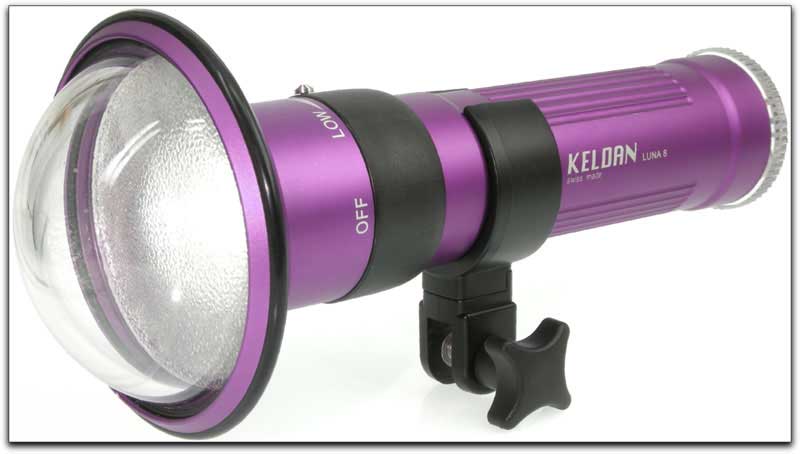
At the apex of current underwater light technology arrives the Swiss made Keldan Luna 8 LA-V-CRI underwater video light which I had the pleasure of trying out on a recent trip to Kona, Hawaii. Keldan, though Swiss made, is distributed by the California company, Nocturnal Lights, whose own lights I have reviewed in the past with fairly glowing coverage of their own excellent quality and outstanding service. They are the main distributers of Keldan Lights for North and South America, Australia and South East Asia.
One of the most famous of dives to do in Kona is the renowned Night Manta Dive. With divers and snorkelers in the water, their lights attract plankton which, in turn, attracts the manta rays, some of which may be ten feet from wing tip to wing tip. These manta rays put on a heck of show twisting and turning, doing barrel rolls and flips within feet of you. The Keldan video lights are the most powerful lights I have ever seen or used that weren't lights whose power came from a service supplied ship as they are when filming one of the IMAX films produced and directed by Michelle and Howard Hall.
The Keldan Luna 8-LA-V CRI lights are self contained. This means that the rechargeable batteries that supply their power are within the lights themselves. Therefore, no extra battery pods or cables, that can hook onto to your gear or onto marine reefs, are necessary. The batteries are rechargeable Li-Ion which, at full power, will last approximately 55 minutes. I did not test burn time at low power but Keldan claims a burn time of up to 220 minutes.
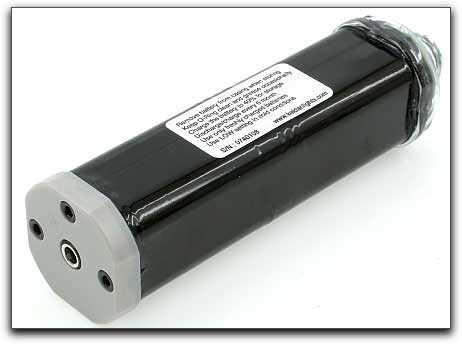
The rear of the Keldan Luna 8-LA-V CRI light unscrews so that the battery can be slid in.
The battery itself has 3 connector holes that are easy to align with the connecters within the Keldan Luna CRI light.
Mounting these lights to whatever underwater housing you may use is a simple matter of choosing which light arms and mounting brackets fit your housing and needs the best. While many divers prefer a stiff arm for light mounting, I preferred the flexible arms provided by Nocturnal Lights http://www.nocturnallights.com as they provide me the ability to quickly change my lighting positions as the need calls for.
They are also considerably less expensive.
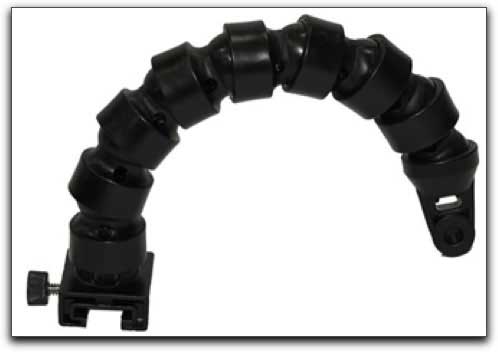
The Nocturnal Light arms are flexible and inexpensive, provide solid support
for your lights and are self draining, a small but important feature in light arms.
Changing a stiff arm, which usually consists of at least two separate sections, requires loosening the hardware that connects them, changing them to the desired position, and then retightening the connector. This can take time and, when filming underwater, you can easily miss an important shot wasting time making these adjustments.
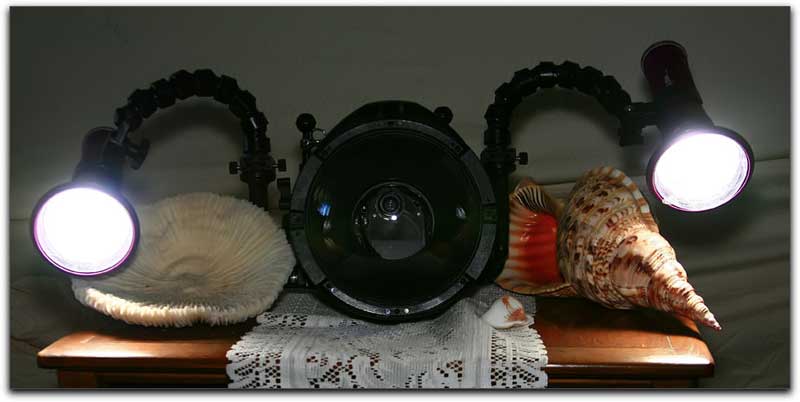
photo by Sherman Worley
The Keldan lights use their own proprietary LED array providing a very pleasing white light with a color temperature of 5,000 Kelvin and a high color rendering of 95(Ra). Often, before a purchase, an underwater videographer will turn the light on in the shop or in a darkened room. She checks for hotspots, the spread of the beam, visible color temperature, and the amount of the throw the light puts out. This gives a fairly good idea of what the light will produce but is not a completely accurate representation of how the light really does perform when used for underwater videography.
Artificial light does not travel very far underwater and, more often then not, underwater video lights are useful for close up and medium shots. Try using them on a shark 40 feet away and they serve almost no useful purpose until the shark comes within range of the light itself. Bottom line, the throw of any underwater video light is limited to its power output. Never the less, the Keldan light easily put out a longer and wider light throw than any of the 50 or so divers in the water for the Manta spectacular. One of my dive buddies on this excursion was using a top of the line underwater video light, one that was just too expensive for me to ever pay for, and the Keldan easily outshone his light with both a wider dispersion, cleaner light, and longer throw. Outstanding is that the Keldan light did not have any hot spots at all and at the outside of its diameter, the fall off of light was very diffused and even. Two of these lights mounted on my housing created a magnificent field from which I could film. Because of this, the manta rays gravitated to me to pose, flip, and roll in front of me as if they were auditioning for a role in a movie. In actuality, the lights attracted more of the plankton in the water which then brought in the Mantas who were feeding to their heart's delight. Taking my eyes away from my subjects just to see, both during the day and at night, how the lights were affecting what I was seeing, I was pleased to notice that the Keldan CRI light did not introduce any color artificiality, and despite their significant power, did not blow out my images. While the black and white colors of night time shooting of black and white manta rays really do not show this off, when used during the daytime during a high sun, still no fake hues or off colors were created by the Keldan CRIs.
Filmed with a Canon 7D and the Keldan CRI lights, true coloration is the name of the game. This means considerably less color correction in post production saving me both time and money.
Keldan currently produces two lights which look identical but are not. One is their Luna 8 LA-V Flux and the ones I tested were the Luna 8 LA-V CRI. Both have multiple power settings which are adjusted by a black ring on the main body of the lights supplying 15 to 65 watts of LED power.
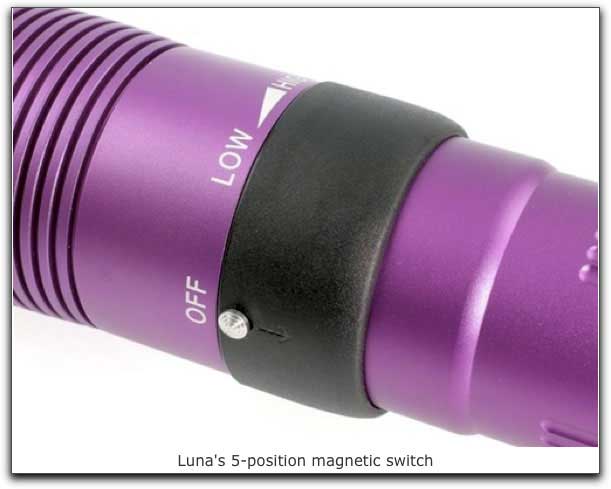
Turning the power ring clockwise incrementally increases the power output. From the off position, a turn counter- clockwise brings you to the light's 'Test' position where a series of 8 small LEDs on the back of the light show you how much of a charge you have left. This is a small but important feature for the underwater cinematographer who will now not be left guessing just how much of a charge is left on a dive; you can see in an instant.
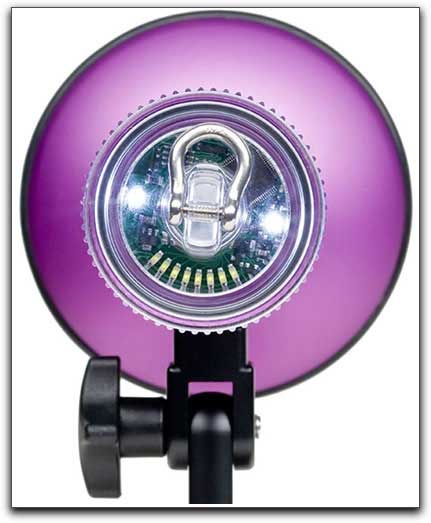
My only real complaint, which also applies to other manufacturers of underwater video lights is the light weight but sizable AC charger. Two of them with their supplied cords can take up valuable room in your camera case. I really do not understand why they must be so big.
Charge time from a depleted battery is approximately 4 hours. If you have used your light a great deal on one dive, I would suggest that having an extra set of light batteries may be a good thing. Use one set while your second set is charging up.
A valuable feature is that from the off position, you must press and slide a small magnetic switch to turn the light either to the test position or to power on. This button acts as a lock preventing accidentally turning the light on and running down your battery or have it accidentally turned on in your camera case. Both produce 90° of coverage with a very smooth gradient of light at the outer edges and both have the same physical dimensions. These lights are not small, nor all that light at 2.2 lb. dry weight(0.3 lb. in the water), and approximately 11" long. However, they fit very neatly in my camera bag and were not in the least awkward to set up. In the water, they felt weightless.
The exposed polycarbonate dome port looks a bit like a mushroom and I was initially concerned about it getting scratched or broken somehow. At least for travel purpose, I would appreciate some kind of protective neoprene cover for the dome. I had also thought of having a protective device similar to the sun blockers we attach to our DSLRs to prevent accidental bumping of the light dome on coral ledges or similar obstacles, but my guess is that they would get in the way of the Keldan's wide degree of light dispersion. I have been told that Nocturnal Lights is in the process of designing a cover for the dome as I write.
Both models of Keldan lights are rated to 200 meters (656 feet) which is far deeper than I will probably ever dive. Due to the Keldan's thermal protection it can also be used above the surface and produces almost no heat at all, a big concern for videographers back in the day. There is no question that these lights feel and perform like a professional light should.
So, with all other elements of the two models of lights being the same, what is the significant difference between the Flux and CRI models? To begin with the Flux model shines with 5,000 lumens at 5,000 kelvin while the CRI model produces 3,000 lumens at 5,000 kelvin. Just how important a difference is this? In my opinion, after using the CRI lights on my Nauticam housing, the lumen level difference was not as great a factor as one might think. In fact, long before I ever tried out the Keldan lights it was becoming a personal opinion that too many manufacturers of underwater video lights were making too much of a big deal when advertising their light's lumens ability. For close up or medium shots, too much power would blow out an image anyway forcing you to move to a lower setting. How colors are rendered underwater is a much more important consideration in my opinion.
Color Rendering Index
CRI is a scale indicating a lamp's ability to render an object's color accurately and stands for Color Rendering Index with a rating of 100 being the very best. CRI is actually a measure of the quality of color light as established by the International Commission on Illumination. A CRI rating of 95, which is what the Keldan CRI light is rated as, will allow your eyes and photo/video cameras to capture colors that are much more accurate than clips shot with a CRI rating of 80. Lights with ratings of 80 and below can produce significant color shifts and loss of color saturation and resolution. Since natural color, when properly measured, lays between 5,000k and 6,000k, which simulates natural daylight, the CRI of a light must achieve a high rating between those kelvin temperatures. A CRI rating of a 3,000k light may be high but because the kelvin rating is low, the colors will not look as they should and will result in poor color rendering and will not be captured properly by your camera or camcorder. This results in even more post production color correction chores. A phosphor based LED with a higher CRI will ALWAYS have a better color rendering capability than another phosphor based white LED with a lower CRI. This means that we can confidently use the CRI as a relative measure to compare color rendering quality of a similar light source (which is absolutely the case with UW LED lighting). Thus, while the Keldan Flux version has a higher light output and is designed for maximizing available light, the Keldan Luna 8 LA-V CRI, the subject of this review, will capture the most vivid and true to life colors.
The charts indicating range of colors utilizing the Keldan Luna 8 LA-V CRI light clearly shows
a superior range of captured colors as opposed to the standard LED light that may be on the market.
Summary Opinion
For underwater work, capturing the colors that disappear the deeper you go without proper lighting, the Keldan Luna 8 LA-V CRI lights are a shooter's dream light. While I had been impressed when trying them out in a dark room, I did not expect such a beautiful and even throw of light underwater. For those who really need even more lighting power for certain filming situations, the Keldan Luna 8 Flux light, at 5,000 lumens, will surely not disappoint, and I look forward to a possible review of them in the future. Actually, I am understating the Keldan Luna 8 LA-V CRI light in the effort to avoid the appearance of unnecessary hyperbole. That said, a gauntlet has been thrown down as these underwater video lights, while not inexpensive, are made to last, and blow any other light I have yet to use out of the water. They are that good.
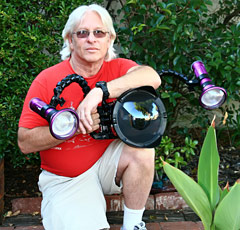 Steve Douglas is a certified Apple Pro for Final Cut Pro 7 and underwater videographer. A winner of the 1999 Pacific Coast Underwater Film Competition, 2003 IVIE competition, 2004 Los Angeles Underwater Photographic competition, and the prestigious 2005 International Beneath the Sea Film Competition, where he also won the Stan Waterman Award for Excellence in Underwater Videography and 'Diver of the Year', Steve was a safety diver on the feature film "The Deep Blue Sea", contributed footage to the Seaworld Park's Atlantis production, and productions for National Geographic and the History channels. Steve was a feature writer for Asian Diver Magazine and is one of the founding organizers of the San Diego UnderSea Film Exhibition. He is available for both private and group seminars for Final Cut Pro and leads underwater filming expeditions and African safaris with upcoming excursions to the Cocos Islands, Costa Rica, and Hawaii. Feel free to contact him if you are interested in joining Steve on any of these exciting trips. www.worldfilmsandtravel.com Steve Douglas is a certified Apple Pro for Final Cut Pro 7 and underwater videographer. A winner of the 1999 Pacific Coast Underwater Film Competition, 2003 IVIE competition, 2004 Los Angeles Underwater Photographic competition, and the prestigious 2005 International Beneath the Sea Film Competition, where he also won the Stan Waterman Award for Excellence in Underwater Videography and 'Diver of the Year', Steve was a safety diver on the feature film "The Deep Blue Sea", contributed footage to the Seaworld Park's Atlantis production, and productions for National Geographic and the History channels. Steve was a feature writer for Asian Diver Magazine and is one of the founding organizers of the San Diego UnderSea Film Exhibition. He is available for both private and group seminars for Final Cut Pro and leads underwater filming expeditions and African safaris with upcoming excursions to the Cocos Islands, Costa Rica, and Hawaii. Feel free to contact him if you are interested in joining Steve on any of these exciting trips. www.worldfilmsandtravel.com
copyright © Steve Douglas 2011
This article first appeared on www.kenstone.net and is reprinted here with permission.
All screen captures and textual references are the property and trademark of their creators/owners/publishers.
|